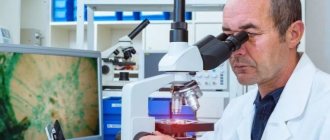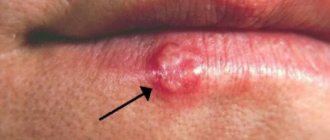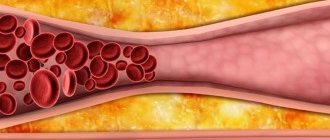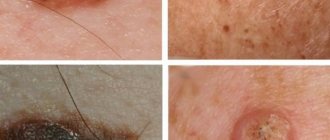Keratoma is a benign formation on the skin that appears due to a local accumulation of horny cells of the epidermis. Outwardly, such manifestations resemble convex pigment spots with hard scales on the surface. And they are often located on the face, forearms, upper back, and arms.
Single or multiple keratomas are typical for mature people over 40 years of age. This skin pathology is rarely encountered in children and young people. They appear equally in men and women. Cases of self-healing have been recorded when formations of this type disappeared by themselves. But often raised dark spots reappear in the same areas of the skin.
Are keratomas dangerous? Do they need to be treated or not? How to get rid of keratomas at home? The specialists of the Medical Center for the Diagnostics of Moles “Lazersvit” have the answers to all these questions.
Keratomas: causes of appearance?
Keratoma, according to dermatologists, develops for one of two reasons - excessive ultraviolet radiation and the physiological processes of aging of the skin. The predisposition to the development of pathology, according to medical experts and geneticists, is inherited. But there are no clear reasons for the appearance of a formation, such as, for example, in condyloma, which is caused by the human papillomavirus. At one point, an accumulation of cells is observed, which leads to an anomaly.
Skin keratoma, as a rule, does not pose a threat to health. But dermatologists strongly recommend observing the spots. After all, individual formations have a tendency to reproduce and grow. And in rare cases, they degenerate into malignant neoplasms.
Treatment methods
Need advice from an experienced doctor?
Get a doctor's consultation online. Ask your question right now.
Ask a free question
This pathology is typical for older people; classical methods of therapy may not be suitable due to the presence of many absolute and relative contraindications due to age characteristics and concomitant diseases.
Age-related (seborrheic) growths do not pose any danger or physical discomfort; doctors seek help for aesthetic reasons when the growths are located on the face.
Some warts are a symptom of other somatic disorders, which requires additional diagnosis.
Surgical removal
Surgical method is the traditional treatment option. In surgery, treatment is used only in the following cases:
- the likelihood of degeneration into a malignant tumor;
- inconvenient location when permanent damage occurs;
- when the process is pronounced and has a multiple character.
The essence of the operation:
- Inspection, selection of location and volume of surgery.
- Preparation of the surgical field. Treatment with an antiseptic solution (betadine).
- Conducting anesthesia (novocaine or lidocaine).
Individual intolerance to the anesthetic may occur.
- Tissue dissection, excision of the pathological area within healthy tissue.
- Antiseptic treatment.
- Skin suture with re-treatment with betadine.
- Applying an aseptic dressing.
Advantages of the operation:
- low probability of reappearance in the same place;
- acceptable price;
- get rid of pathological tissues as much as possible, which is important in the case of a malignant tumor.
Negative sides:
- a scar remains;
- the likelihood of infectious complications;
- relatively long healing.
Hardware procedures
Hardware procedures include:
- cryodestruction;
- radio wave method;
- laser removal.
Cryodestruction - the use of liquid nitrogen, low temperature allows you to destroy pathological tissue without damaging healthy tissue. The procedure is practically not felt, and no scars are formed. The pathological focus will not disappear immediately, but after a few weeks. This method is safe for older people
Radio wave - the use of high-frequency radio waves. The peculiarity of the method is the accuracy of execution, short procedure time and the likelihood of application in hard-to-reach places (on the eyelids).
Laser removal – layer-by-layer removal of cells with a special laser. It involves eliminating a cosmetic defect in several sessions; it will not be possible to remove everything at once. But the procedure has no age restrictions, is bloodless due to cauterization of blood vessels, and is short in duration.
Traditional methods of treatment
Traditional medicine allows you to treat keratopapillomas on the skin at home yourself. Treatment with folk remedies is varied.
| Onion | For the recipe you need onion peels, which it is advisable to chop, pour the dried peels into a jar and pour in table vinegar, leave for 14 days in a dark place. Then filter the tincture and apply externally (make compresses). First for half an hour, and then increase the time to 3 hours. Result: the wart should soften, which will reduce the likelihood of injury. |
| Propolis | The therapeutic effect of propolis slows down the growth of malformation. Propolis is kneaded until smooth and applied to the affected area for 5 days. You can secure it with a plaster or bandage. |
| Castor oil | This method requires warm oil. It must be rubbed into the malformation daily. As a result, education will decrease or growth will slow down. |
| Nuts | You will need to collect unripe nuts and remove the crust from them. Grind it and add it to your regular hand cream. Use the product twice a day. |
Why should a keratoma be observed?
The skin disease keratoma is considered by oncologists to be a borderline formation, especially in patients with an increased risk of cancer. The probability of malignancy into melanoma or basal cell carcinoma varies in different age groups in the range of 8-35%. For this reason, people who have one or more formations of this type are recommended to see a dermatologist. Regular visits to the doctor allow you to notice signs of degeneration in the early stages and begin treatment in a timely manner. Well, it’s better to remove the protruding spot in order to prevent even the minimal likelihood of pathological processes.
The risk of cancer is not the only reason to see a doctor. Keratoma on the face is perceived as a cosmetic defect, attracts the attention of others, and becomes the cause of complexes. A convex formation on the body can be injured by tight clothing or accessories. In this case, there is a threat of secondary infection.
Age-related keratoma “loves” to grow on the scalp. The formation is often damaged by a comb and hairdresser's accessories during cutting and styling.
Each case of keratoma requires an individual approach. And only a qualified doctor can give recommendations to the patient - treat or remove, ignore or observe.
Social adaptation
Dividing children into “special” and “normal” can quickly turn children with mild disabilities into disabled people who become incapable of independent living and require constant care. Such patients live in a fenced-in world, do not communicate with peers, and are unfamiliar with ordinary childhood hobbies and interests. On the other hand, among healthy children the correct attitude towards people with disabilities has not been formed.
Isolating children labeled as “unteachable” in boarding schools and special schools does not improve the situation. Therefore, these outdated traditions are increasingly being replaced by home education in the circle of relatives who are ready to engage in their development and adaptation in society. Parents, with their support, help to get education, treatment, and communication with peers.
When treated correctly, such patients actively interact with others, and they develop an interest in other people and their activities. Using simple, accessible games, the teacher can begin to communicate with the ward and teach him the skills necessary for independent living.
In Western European countries, rehabilitation centers are common, in which patients undergo all stages of adaptation.
In Belgium, one form of such structures is rural communities, in which patients, along with service personnel, participate in organizing life support. They work together in workshops, agriculture, bakeries. In Germany, such communities are common in the form of religious communities. Similar communities have been organized in Russia. In them, patients receive the necessary knowledge, which subsequently contributes to their social adaptation. Mental retardation is a serious and incurable disease, but the caring environment and attentive attitude towards such “special” people will help them find their place in society.
Classification
Keratomas are classified as follows:
- Seborrheic keratoma appears most often on the chest, back and scalp. Initially, this is a yellow-brown spot, the diameter of which can reach 3 cm. Over time, the surface of the formation becomes dense, and scales appear on it. The color changes to dark brown or black. Externally, this skin pathology looks like dried raisins stuck in the skin.
- Senile keratoma affects the skin of people over 35 years of age. A spot with a diameter of up to 2.5 centimeters appears on the skin. Over time, it thickens, becomes crusty, cracks, and changes color from yellow to black. The growth grows slowly, but over time it can protrude above the skin by a centimeter or even more. Senile keratoma, as this type of neoplasm is also called, is often localized on the shoulders, head, and back. Less common on the face and neck. Senile keratomas can grow in colonies. They also often become inflamed due to physical damage.
- Horny keratoma, which dermatologists often call “cutaneous horn,” has an increased risk of degeneration. First, a gray or brown spot appears on the skin, which eventually becomes covered with scales. A convex tubercle with a rough surface is suitable for placement of the arms, chest, and back. But other parts of the body are no exception. Sometimes patients are diagnosed with multiple horny keratomas.
- Follicular keratoma appears on the cheeks, lips, nose, eyelids. The skin first turns pink, then small tubercles grow at the site where the spot appears.
- Angiokeratoma is a nodular formation of red, black or blue color. Its size can reach 10 centimeters, but most often the growth grows to 2-3 centimeters. Often such skin pathologies form on the back, abdomen, legs and genitals.
- At the first stage, solar keratoma looks like a flat mole. Gradually it begins to peel off. Scales form on its surface. Dense lesions are often found in men over 40 years of age. Location: back, face, feet. Education is rarely singular. As a rule, this is a whole colony of growths. In some cases, degeneration into squamous cell carcinoma is diagnosed.
The type of keratoma and its risks for the patient are diagnosed by a dermatologist after examining the formation.
Make an appointment with a dermatologist
Why are keratopapillomas dangerous?
Senile papillomas in themselves do not cause any harm to health. But some of them can degenerate into malignant formations, that is, oncology. The likelihood of cancer is especially high with the appearance of solar and horny keratoma. Therefore, if growths are detected, it is necessary to visit a dermatologist and get recommendations for treatment and skin care.
KK Adapt. 5 paragraph
Places where keratopapillomas have formed should be protected from the sun. Since exposure to ultraviolet rays increases the risk of cells degenerating into malignant ones.
Diagnostics
An appointment with a dermatologist begins with taking an anamnesis. The doctor clarifies how long ago the formation was, asks the patient about sensations - painful manifestations, itching, and studies the symptoms. Next, the skin is examined to determine the size and location of the keratoma. The instrumental method - dermatoscopy - allows you to clarify the diagnosis and exclude other skin diseases.
A special device allows you to identify the formation, examine the structure of its tissues, and the depth of its occurrence. The dermatoscope magnifies the image many times, so errors are excluded. And if there is a risk of the keratoma degenerating into a tumor, the doctor will determine this. In some cases, histology is recommended - the formation is sent to the laboratory to determine the cellular composition.
What does it represent?
Keratopapilloma of the skin is a keratinized papilloma that has transformed into a keratoma. The neoplasm looks like a growth on the epidermis. At first it is simple pigmentation, which tends to grow rapidly. In a short time it becomes a full-fledged keratoma.
The disease usually appears in older people. Most often, a growth on the skin occurs in a person who has crossed the fifty-year threshold if he has a dry type of epidermis. Similar papillomas also occur in people over 40 years of age. Skin formations do not bother people younger than this age, since their immune system successfully copes with the pathology.
Places of localization of formations are open areas of the epidermis.
Keratoma: how to treat?
To help the patient get rid of keratoma or actinic keratosis, the doctor prescribes a conservative or surgical treatment method. If drug therapy does not produce results, if the location of the formation is unsuccessful, if it is perceived as a cosmetic defect, surgery to remove the keratoma is prescribed.
Drug therapy
Drug treatment involves the use of various ointments, solutions or emulsions with active substances. It is immediately important to note that such methods are effective in the initial stages, when the stain has just appeared. Therapy must be prescribed by a doctor. Self-medication is strictly not recommended, as it can cause complications in the form of damage to surrounding healthy tissue.
Keratoma: how to remove surgically?
The keratoma is surgically removed using one of the following methods:
- laser method;
- cryodestruction;
- radiosurgery method.
The leader of choice is laser removal, since it minimizes the risks of negative consequences, bleeding, wound infection, and relapses. In a few minutes the formation is completely removed. And the wound heals within a few days.
Possible risks
Attempts to remove the keratoma yourself by tying it with thread or cauterizing it with aggressive media are strictly prohibited. This can lead to serious consequences, including the degeneration of a benign tumor into cancer.
Indications for senile wart removal
The decision to remove the tumor is made by the doctor together with the patient. If keratopapilloma causes only aesthetic problems, then it is not necessary to resort to surgery. But it is necessary to monitor the growth and condition of papilloma. But in some cases, the keratoma must be removed:
- When there are signs of tissue degeneration into malignant ones. This can be assumed by a sharp increase in the size of the wart, a change in color, and the appearance of bleeding or inflammation.
- The growth is located in an area where it experiences pressure from clothing or causes discomfort.
- Constantly injured.
- A group of papillomas occupies a large area of skin.
Keratopapilloma can be removed at the request of the patient without other indications.
Contraindications and consequences of removal of condylomas and papillomas
After removal of condylomas and papillomas, it is necessary to follow the doctor’s recommendations to prevent recurrent manifestations of HPV. In particular, a dermatologist may recommend the use of local antiviral drugs and drugs that stimulate the body's protective functions.
Contraindications for removal of condylomas and papillomas are:
- inflammatory skin diseases;
- acute febrile conditions;
- oncological diseases;
- chronic diseases in the acute stage.
To undergo an examination of skin tumors in Sumy, as well as to remove condylomas and papillomas, call the numbers listed on the website or fill out the online registration form. Applications for an appointment with a doctor at the medical center are accepted 24 hours a day.











